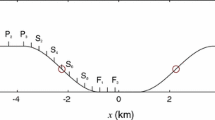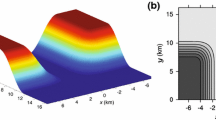Abstract
Semi-idealized model simulations are made of the nocturnal cold-air pool development in the approximately 1-km wide and 100–200-m deep Grünloch basin, Austria. The simulations show qualitatively good agreement with vertical temperature and wind profiles and surface measurements collected during a meteorological field expedition. A two-layer stable atmosphere forms in the basin, with a very strong inversion in the lowest part, below the approximate height of the lowest gap in the surrounding orography. The upper part of the stable layer is less strongly stratified and extends to the approximate height of the second-lowest gap. The basin atmosphere cools most strongly during the first few hours of the night, after which temperatures decrease only slowly. An outflow of air forms through the lowest gap in the surrounding orography. The outflow connects with a weak inflow of air through a gap on the opposite sidewall, forming a vertically and horizontally confined jet over the basin. Basin cooling shows strong sensitivity to surface-layer characteristics, highlighting the large impact of variations in vegetation and soil cover on cold-air pool development, as well as the importance of surface-layer parametrization in numerical simulations of cold-air-pool development.














Similar content being viewed by others
References
Aigner S (1952) Die Temperaturminima im Gstettnerboden bei Lunz am See, Niederösterreich [The temperature minima in the Gstettner basin near Lunz, Lower Austria]. Wetter Leb Spec Issue 1:34–37
Arduini G, Staquet C, Chemel C (2016) Interactions between the nighttime valley-wind system and a developing cold-air pool. Boundary-Layer Meteorol 161:49–72
Billings BJ, Grubis̆ić V, Borys RD (2006) Maintenance of a mountain valley cold pool: a numerical study. Mon Weather Rev 134:2266–2278
Bryan GH, Fritsch JM (2002) A benchmark simulation for moist nonhydrostatic numerical models. Mon Weather Rev 130:2917–2928
Burns P, Chemel C (2014) Evolution of cold-air-pooling processes in complex terrain. Boundary-Layer Meteorol 150:423–447
Chemel C, Arduini G, Staquet C, Largeron Y, Legain D, Tzanos D, Paci A (2016) Valley heat deficit as a bulk measure of wintertime particulate air pollution in the Arve River Valley. Atmos Environ 128:208–215
Chou M-D, Suarez MJ (1994) An efficient thermal infrared radiation parameterization for use in general circulation models. Tech Memo TM-104606, NASA
Clements CB, Whiteman CD, Horel JD (2003) Cold-air-pool structure and evolution in a mountain basin: Peter Sinks, Utah. J Appl Meteorol 42:752–768
De Wekker SFJ, Whiteman CD (2006) On the time scale of nocturnal boundary layer cooling in valleys and basins and over plains. J Appl Meteorol Climatol 45:813–820
Dorninger M, Whiteman CD, Bica B, Eisenbach S, Pospichal B, Steinacker R (2011) Meteorological events affecting cold-air pools in a small basin. J Appl Meteorol Climatol 50:2223–2234
Doyle JD, Epifanio CC, Persson A, Reinecke PA, Zngl G (2012) Mesoscale modeling over complex terrain: numerical and predictability perspectives. In: Chow FK, DeWekker SFJ, Snyder B (eds) Mountain weather research and forecasting. Springer, Dordrecht, pp 531–589
Fast JD, Zhong S, Whiteman CD (1996) Boundary layer evolution within a canyonland basin. Part II: numerical simulations of nocturnal flows and heat budgets. J Appl Meteorol 35:2162–2178
Gary JM (1973) Estimate of truncation error in transformed coordinate, primitive equation atmospheric models. J Atmos Sci 30:223–233
Grell GA, Dudhia J, Stauffer DR (1995) A description of the fifth-generation Penn State/NCAR mesoscale model (MM5). NCAR Tech Note NCAR/TN-398+STR, National Center for Atmospheric Research, 122 pp
Haiden T, Whiteman CD, Hoch SW, Lehner M (2011) A mass flux model of nocturnal cold-air intrusions into a closed basin. J Appl Meteorol Climatol 50:933–943
Ha K-J, Mahrt L (2003) Radiative and turbulent fluxes in the nocturnal boundary layer. Tellus 55A:317–327
Hart KA, Steenburgh WJ, Onton DJ, Siffert AJ (2004) An evaluation of mesoscale-model-based model output statistics (MOS) during the 2002 Olympic and Paralympic Winter Games. Weather Forecast 19:200–218
Hoch SW, Whiteman CD, Mayer B (2011) A systematic study of longwave radiative heating and cooling within valleys and basins using a three-dimensional radiative transfer model. J Appl Meteorol Climatol 50:2473–2489
Kiefer MT, Zhong S (2011) An idealized modeling study of nocturnal cooling processes inside a small enclosed basin. J Geophys Res 116:D20127
Kiefer MT, Zhong S (2013) The effect of sidewall forest canopies on the formation of cold-air pools: a numerical study. J Geophys Res 118:5965–5978
Kiefer MT, Zhong S (2015) The role of forest cover and valley geometry in cold-air pool evolution. J Geophys Res Atmos 120:8693–8711
Lareau NP, Crosman E, Whiteman CD, Horel JD, Hoch SW, Brown WOJ, Horst TW (2013) The persistent cold-air pool study. Bull Am Meteorol Soc 94:51–63
Largeron Y, Staquet C (2016a) The atmospheric boundary layer during wintertime persistent inversions in the Grenoble Valleys. Front Earth Sci 4:70
Largeron Y, Staquet C (2016b) Persistent inversion dynamics and wintertime \(\text{ PM }_{10}\) air pollution in Alpine valleys. Atmos Environ 135:92–108
Louis J-F (1979) A parametric model of vertical eddy fluxes in the atmosphere. Boundary-Layer Meteorol 17:187–202
Malek E, Davis T, Martin RS, Silva PJ (2006) Meteorological and environmental aspects of one of the worst national air pollution episodes (January, 2004) in Logan, Cache Valley, Utah, USA. Atmos Res 79:108–122
Mihailović DT, Janjić ZI (1986) Comparison of methods for reducing the error of the pressure gradient force in sigma coordinate models. Meteorol Atmos Phys 35:177–184
Pataki DE, Tyler BJ, Peterson RE, Nair AP, Steenburgh WJ, Pardyjak ER (2005) Can carbon dioxide be used as a tracer of urban atmospheric transport? J Geophys Res 110:D15102
Pope CA III, Muhlestein JB, May HT, Renlund DG, Anderson JL, Horne BD (2006) Ischemic heart disease events triggered by short-term exposure to fine particulate air pollution. Circulation 114:2443–2448
Pospichal B, Eisenbach S, Whiteman CD, Steinacker R, Dorninger M (2003) Observations of the cold air outflow from a basin cold pool through a low pass. In: Proceedings of international conference on Alpine meteorology 2003
Price JD, Vosper S, Brown A, Ross A, Clark P, Davies F, Horlacher V, Claxton B, McGregor JR, Hoare JS, Jemmett-Smith B, Sheridan P (2011) COLPEX: field and numerical studies over a region of small hills. Bull Am Meteorol Soc 92:1636–1650
Reddy PJ, Barbarick DE, Osterburg RD (1995) Development of a statistical model for forecasting episodes of visibility degradation in the Denver metropolitan area. J Appl Meteorol 34:616–625
Reeves HD, Lin Y-L (2006) Effect of stable layer formation over the Po valley on the development of convection during MAP IOP-8. J Atmos Sci 63:2567–2584
Sauberer F (1946) 100 Kilometer von Wien: 51 Grad unter Null [100 kilometres from Vienna: 51 degrees below zero]. Universum 5:105–107
Savijärvi H (2006) Radiative and turbulent heating rates in the clear-air boundary layer. Q J R Meteorol Soc 132:147–161
Schmidt W (1930) Die tiefsten Minimumtemperaturen in Mitteleuropa [The lowest minimum temperatures in central Europe]. Die Naturwissenschaften 18:367–369
Schmidt W (1933) Kleinklimatische Beobachtung in Österreich [Microclimatic observations in Austria]. Geogr Jahresbericht Österreich 16:53–59
Schmidt W, Gams H, Kühnelt W, Furlani J, Müller H (1929) Bioklimatische Untersuchungen im Lunzer Gebiet [Bioclimatic investigations in the Lunz region]. Die Naturwissenschaften 17:176–179
Sheridan PF, Vosper SB, Brown AR (2014) Characteristics of cold pools observed in narrow valleys and dependence on external conditions. Q J R Meteorol Soc 140:715–728
Silcox GD, Kelly KE, Crosman ET, Whiteman CD, Allen BL (2012) Wintertime \(\text{ PM }_{2.5}\) concentrations during persistent, multi-day cold-air pools in a mountain valley. Atmos Environ 46:17–24
Skamarock WC, Klemp JB, Dudhia J, Gill DO, Barker DM, Duda MG, Huang X-Y, Wang W, Powers JG (2008) A description of the advanced research WRF version 3. NCAR technical report of NCAR/TN-475, Mesoscale and Microscale Meteorology Division, National Center for Atmospheric Research, 113 pp
Steinacker R, Whiteman CD, Dorninger M, Pospichal B, Eisenbach S, Holzer AM, Weihs P, Mursch-Radlgruber E, Baumann K (2007) A sinkhole field experiment in the eastern Alps. Bull Am Meteorol Soc 88:701–716
Tao W-K, Lang S, Simpson J, Sui C-H, Ferrier B, Chou M-D (1996) Mechanism of cloud–radiation interaction in the tropics and midlatitude. J Atmos Sci 53:2624–2651
Vosper SB, Hughes JK, Lock AP, Sheridan PF, Ross AN, Jemmett-Smith B, Brown AR (2014) Cold-pool formation in a narrow valley. Q J R Meteorol Soc 140:699–714
Whiteman CD, Eisenbach S, Pospichal B, Steinacker R (2004a) Comparison of vertical soundings and sidewall air temperature measurements in a small Alpine basin. J Appl Meteorol 43:1635–1647
Whiteman CD, Haiden T, Pospichal B, Eisenbach S, Steinacker R (2004b) Minimum temperatures, diurnal temperature ranges and temperature inversions in limestone sinkholes of different size and shape. J Appl Meteorol 43:1224–1236
Whiteman CD, Pospichal B, Eisenbach S, Weihs P, Clements CB, Steinacker R, Mursch-Radlgruber E, Dorninger M (2004c) Inversion breakup in small Rocky Mountain and Alpine basins. J Appl Meteorol 43:1069–1082
Whiteman CD, De Wekker SFJ, Haiden T (2007) Effect of dewfall and frostfall on nighttime cooling in a small, closed basin. J Appl Meteorol Climatol 46:3–13
Whiteman CD, Muschinski A, Zhong S, Fritts D, Hoch SW, Hahnenberger M, Yao W, Hohreiter V, Behn M, Cheon Y, Clements CB, Horst TW, Brown WOJ, Oncley SP (2008) METCRAX 2006—meteorological experiments in Arizona’s Meteor Crater. Bull Am Meteorol Soc 89:1665–1680
Whiteman CD, Hoch SW, Lehner M, Haiden T (2010) Nocturnal cold air intrusions into a closed basin: observational evidence and conceptual model. J Appl Meteorol Climatol 49:1894–1905
Whiteman CD, Hoch SW, Horel JD, Charland A (2014) Relationship between particulate air pollution and meteorological variables in Utah’s Salt Lake Valley. Atmos Environ 94:742–753
Xue M, Droegemeier KK, Wong V (2000) The Advanced Regional Prediction System (ARPS)—a multi-scale nonhydrostatic atmosphere simulation and prediction model. Part I: model dynamics and verification. Meteorol Atmos Phys 75:463–485
Xue M, Droegemeier KK, Wong V, Shapiro A, Brewster D, Carr F, Weber D, Liu Y, Wang D (2001) The Advanced Regional Prediction System (ARPS)—a multi-scale nonhydrostatic atmosphere simulation and prediction tool. Part II: model physics and applications. Meteorol Atmos Phys 76:143–165
Zängl G (2002) An improved method for computing horizontal diffusion in a sigma-coordinate model and its application to simulations over mountainous topography. Mon Weather Rev 130:1423–1432
Acknowledgements
This project was funded by the National Science Foundation through Grant AGS-1361863. Observational data for the model evaluation have been collected during a field course of the University of Vienna. We thank the students for their enthusiasm in setting up the instruments and running them during the cold nights. Mr. Kupelwieser is thanked for providing access to the Grünloch experimental area. Finally, we are grateful for the helpful comments from three anonymous reviewers.
Author information
Authors and Affiliations
Corresponding author
Rights and permissions
About this article
Cite this article
Lehner, M., Whiteman, C.D. & Dorninger, M. Inversion Build-Up and Cold-Air Outflow in a Small Alpine Sinkhole. Boundary-Layer Meteorol 163, 497–522 (2017). https://doi.org/10.1007/s10546-017-0232-7
Received:
Accepted:
Published:
Issue Date:
DOI: https://doi.org/10.1007/s10546-017-0232-7




